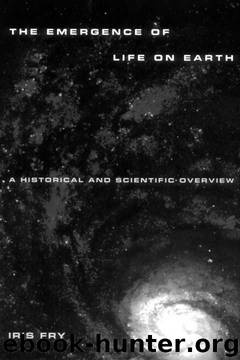Emergence of Life on Earth: A Historical and Scientific Overview by Iris Fry

Author:Iris Fry
Language: eng
Format: epub
Published: 2008-01-04T08:33:00+00:00
WACHTERSHAUSER'S THEORY: THE EMERGENCE OF LIFE ON CRYSTALS OF "FOOL'S GOLD"
Unlike the mathematical models of Dyson and Kauffman, a few other metabolism theories are based on detailed chemical and biochemical processes, referring to specific characteristics of prebiotic chemistry. Among these theories, one of the most original and extensive was developed recently by the German organic chemist Gunter Wachtershauser. Wachtershauser's biography is quite unusual. Following training as an organic chemist, he became a lawyer specializing in patent law. His consuming interest in the problem of the origin of life led to his first articles on the subject, which were published in the 1980s with the encouragement of the renowned philosopher of science Karl R. Popper. Wachtershauser professes to have based the methodology of his investigations on the tenets of Popper's philosophy of science, especially the rejection of "the imagined need to derive biology from chemistry" (Wachtershauser 1992:88). He claims that though the laws of chemistry constrain the myriad biological possibilities, a theory of the emergence of life, which he regards as equivalent to a theory of the emergence of biochemical pathways, is a biological theory (Wachtershauser 1992:88). It is interesting to speculate whether Popper's encounter with Wachtershauser's ideas could have changed the philosopher's attitude toward the origin-of-life problem. Previously, following Monod's contention that life emerged from inanimate matter by an extremely improbable combination of chance circumstances, Popper claimed that the origin of life is "an impenetrable barrier to science and a residue to all attempts to reduce biology to chemistry and physics" (Popper 1974:270). Accepting an emergence-of-life theory, he it Wachtershauser's or someone else's, would amount to an acknowledgment that the origin of life is not impenetrable to science and that there is a way to bridge the gap between chemistry and biology without having to reduce the latter to the former.
Wachtershauser rejects most of the basic assumptions underlying other origin-of-life models, and his theory thus forms a category of its own. All the soup theories suggested so far-both metabolic and genetic-assume that the first biological systems depended on taking up food, in the form of organic compounds, from their environment. These basic organic compounds were supposed to be made from simple inorganic constituents. There is thus a common assumption that emerging life was heterotrophic, that is, it got its food from an external source (hetero-other in Greek; trophe- food). Wachtershauser, on the other hand, contends that the first organism was an autotroph, self-feeding-capable of synthesizing all its organic carbon constituents from carbon dioxide (CO,) or from other simple inorganic carbon molecules. Autotrophy is very common among extant organisms, the most familiar example being plants, which synthesize their food from carbon dioxide and water under the influence of solar energy. According to Wachtershauser, there are two major reasons why all other origin-of-life theories deny the possibility of an autotrophic origin. First, postulating that various organic substances were synthesized in the prebiotic environment, different syntheses can be imagined to have taken place under diverse chemical conditions and in different locales, for instance in meteorites or in the deep ocean.
Download
This site does not store any files on its server. We only index and link to content provided by other sites. Please contact the content providers to delete copyright contents if any and email us, we'll remove relevant links or contents immediately.
Man-made Catastrophes and Risk Information Concealment by Dmitry Chernov & Didier Sornette(5956)
The Revenge of Geography: What the Map Tells Us About Coming Conflicts and the Battle Against Fate by Kaplan Robert D(4052)
Zero Waste Home by Bea Johnson(3804)
COSMOS by Carl Sagan(3588)
Good by S. Walden(3520)
In a Sunburned Country by Bill Bryson(3506)
The Fate of Rome: Climate, Disease, and the End of an Empire (The Princeton History of the Ancient World) by Kyle Harper(3030)
A Wilder Time by William E. Glassley(2835)
Camino Island by John Grisham(2778)
Organic Mushroom Farming and Mycoremediation by Tradd Cotter(2661)
The Ogre by Doug Scott(2657)
Human Dynamics Research in Smart and Connected Communities by Shih-Lung Shaw & Daniel Sui(2479)
Energy Myths and Realities by Vaclav Smil(2463)
The Traveler's Gift by Andy Andrews(2435)
9781803241661-PYTHON FOR ARCGIS PRO by Unknown(2342)
Inside the Middle East by Avi Melamed(2325)
Birds of New Guinea by Pratt Thane K.; Beehler Bruce M.; Anderton John C(2236)
A History of Warfare by John Keegan(2212)
And the Band Played On by Randy Shilts(2165)
